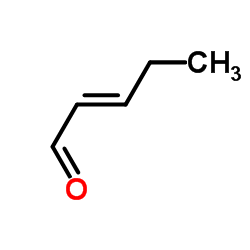Kinetics studies of the gas-phase reactions of NO3 radicals with series of 1-alkenes, dienes, cycloalkenes, alkenols, and alkenals.
Zhijun Zhao, Samir Husainy, Geoffrey D Smith
Index: J. Phys. Chem. A 115(44) , 12161-72, (2011)
Full Text: HTML
Abstract
The gas-phase reactions of NO(3) radicals with series of 1-alkenes, dienes, cycloalkenes, alkenols, and alkenals were studied in pure N(2) or 20% O(2)/80% N(2) bath gas at room temperature and atmospheric pressure using a relative rates technique. Rate coefficients were derived from rates of loss of the organic compounds observed using a chemical ionization mass spectrometer. No difference in the measured kinetic data was observed in the presence or absence of O(2). The rate coefficients obtained (k (10(-13) cm(3) molecule(-1) s(-1)), with uncertainties representing 95% confidence intervals) are as follows: 1-hexene, 0.233 ± 0.021; 1-heptene, 0.245 ± 0.029; 1-octene, 0.292 ± 0.044; 1,3-butadiene, 1.24 ± 0.09; isoprene, 6.24 ± 0.11; 2,3-dimethyl-1,3-butadiene, 14.1 ± 0.5; 1,3-cyclohexadiene, 112 ± 8; cyclopentene, 4.82 ± 0.13; cyclohexene, 5.38 ± 0.20; cycloheptene, 5.28 ± 0.23; 2-buten-1-ol (crotyl alcohol), 3.23 ± 0.12; cis-2-penten-1-ol, 3.11 ± 0.11; cis-2-hexen-1-ol, 3.81 ± 0.38; trans-2-pentenal, 0.193 ± 0.040; trans-2-hexenal, 0.136 ± 0.029; trans-2-heptenal, 0.231 ± 0.036; cis-4-heptenal, 4.03 ± 0.24. The measured rate coefficients are compared to values from previous studies and three structure-activity relationships (SARs), and good agreement is found, in general. In particular, the recently developed SAR of Kerdouci et al. (Kerdouci, J.; Picquet-Varrault, B.; Doussin, J. ChemPhysChem2010, 11, 3909-3920.) is found to estimate the rate coefficients within 35% for all of the measured reactions except for NO(3) + 1,3-butadiene. The SAR prediction for that reaction is nearly 50% lower than the measured value, suggesting that it underestimates the effect of conjugation on the reaction of NO(3) with this small diene. The measured rate coefficients for reactions with a series of alkenols are used to modify the SAR substituent factor for the -CH(2)OH group, and those for reactions with a series of trans-2-alkenals are used to derive a substituent factor for the -C(O)H group, which was not included in the original SAR because of insufficient experimental data.
Related Compounds
| Structure | Name/CAS No. | Molecular Formula | Articles |
|---|---|---|---|
 |
(E)-2-Pentenal
CAS:1576-87-0 |
C5H8O |
|
Comparison of Aroma-Active Volatiles in Oolong Tea Infusions...
2015-09-02 [J. Agric. Food Chem. 63 , 7499-510, (2015)] |
|
Long-acting antituberculous therapeutic nanoparticles target...
2014-12-01 [FASEB J. 28(12) , 5071-82, (2014)] |
|
Transient receptor potential ankyrin 1 (TRPA1) channel as em...
2010-07-22 [J. Med. Chem. 53 , 5085-107, (2010)] |
|
Noxious compounds activate TRPA1 ion channels through covale...
2007-02-01 [Nature , 1-4, (2007)] |
|
Comparison of tomatillo and tomato volatile compounds in the...
2010-04-01 [J. Food Sci. 75(3) , C268-73, (2010)] |